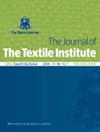混纺纱线基针织物的电、电磁屏蔽及一些物理性能
IF 1.5
4区 工程技术
Q2 MATERIALS SCIENCE, TEXTILES
引用次数: 40
摘要
近年来,人们对含金属线的电磁屏蔽防护织物进行了越来越多的研究。本文采用腈纶(PAC)纱线与两种不同直径的不锈钢丝混合而成的单股和双股混合纱线,编织出平纹和罗纹结构的混纺织物。测量了材料的物理性能,包括电导率、透气性、起球性、耐磨性以及电磁屏蔽效能(EMSE)。研究了针织混纺织物在考虑丝含量和组织结构的情况下,其EMSE、反射、吸收、透射等物理性能的变化。结果表明,线材含量的增加显著提高了电导率。罗纹织物的EMSE值优于平纹织物。双折纱线的织物具有更好的EMSE值。细线织物的EMSE值较高。采用35 μm不锈钢丝的罗纹针织物的EMSE值最高。本文章由计算机程序翻译,如有差异,请以英文原文为准。
Electrical, electromagnetic shielding, and some physical properties of hybrid yarn-based knitted fabrics
Recently, increasing number of studies are performed on protective fabrics containing metal wires for electromagnetic shielding purposes. In the present paper, the hybrid fabrics in plain and rib structures were knitted by using single and double ply hybrid yarns obtained by acrylic (PAC) yarns plied with stainless steel wires having two different diameters. The physical properties including conductivity, air permeability, pilling, and abrasion resistance as well as electromagnetic shielding effectiveness (EMSE) were measured. The variations in EMSE as well as reflection, absorption, and transmission and in other physical properties of knitted hybrid fabrics were investigated considering wire content and weave structure. It was seen that an increase in the wire content significantly increased the conductivity. Rib fabrics exhibited better EMSE values as compared with plain fabrics. Fabrics using two-folded yarns exhibited better EMSE values. Fabrics using thinner wire exhibited higher EMSE values. The highest EMSE value was obtained for rib-knitted fabric with 35 micrometer (μm) stainless steel wire.
求助全文
通过发布文献求助,成功后即可免费获取论文全文。
去求助
来源期刊

Journal of the Textile Institute
工程技术-材料科学:纺织
CiteScore
4.20
自引率
5.90%
发文量
149
审稿时长
1.0 months
期刊介绍:
The Journal of The Textile Institute welcomes papers concerning research and innovation, reflecting the professional interests of the Textile Institute in science, engineering, economics, management and design related to the textile industry and the use of fibres in consumer and engineering applications. Papers may encompass anything in the range of textile activities, from fibre production through textile processes and machines, to the design, marketing and use of products. Papers may also report fundamental theoretical or experimental investigations, including materials science topics in nanotechnology and smart materials, practical or commercial industrial studies and may relate to technical, economic, aesthetic, social or historical aspects of textiles and the textile industry.
All published research articles in The Journal of The Textile Institute have undergone rigorous peer review, based on initial editor screening and anonymized refereeing by two expert referees.
 求助内容:
求助内容: 应助结果提醒方式:
应助结果提醒方式:


